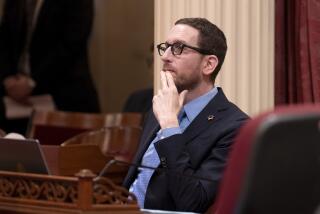Environmental Bill Targets Children
SACRAMENTO — When former Assemblywoman Martha Escutia took up the cause of protecting children from environmental hazards two years ago, she knew it was a longshot.
But even as she watched then-Gov. Pete Wilson veto legislation she introduced on the subject, Escutia (D-Whittier) vowed to continue the fight. Now a state senator, she is promoting a stronger and better-focused bill that has favorable odds.
Central to her measure, SB 25, is the concern that children are more susceptible to environmental threats than adults because their bodies are developing, they are outside more and proportionately they breathe more air.
It seemed a natural issue for Escutia, who has two young children and represents a southeast Los Angeles County district where homes, schools and factories are intermingled.
“We can no longer close our eyes to the injustice facing our children,” she said.
As it recently emerged from the Senate, Escutia’s children’s environmental health protection bill contains several key provisions:
* Specific deadlines for reviewing key air pollutants and their effects on children, beginning with a report to the Legislature by July 1, 2001, listing the first five chemicals the state would scrutinize. (In her bill last year, the review timetable was left more vague.)
* Expanded air quality monitoring, including sampling sites at schools and day-care centers in six unspecified communities statewide. (The earlier bill had been pared down to just three schools.)
* Creation of a Children’s Environmental Health Center within the California Environmental Protection Agency to advise the resources secretary and the governor.
The bill does not include protection for children against exposure to toxic substances in water and food, areas Escutia had also excised from the last session’s bill after learning that they are largely addressed in other laws.
If the bill passes this year it will be a charmed third try. In 1997, the legislation failed in the Assembly.
“I’m back,” Escutia said recently. If the tone of the debate preceding the Senate’s 23-13 vote June 3 is any indication, the bill should easily pass the Assembly, where it is now being considered, and land on the governor’s desk, she said, adding: “None of the Republicans even took me on.”
And, although Gov. Gray Davis has made a policy of not commenting on pending legislation, there are grounds for optimism. As lieutenant governor, Davis sent Escutia a letter in 1998 expressing support for her bill, and during his campaign last year he reiterated that position.
Davis’ budget sets aside $2.24 million for the Air Resources Board to conduct research on the health effects of Fresno’s dirty air on vulnerable populations--namely children, the elderly and people with respiratory ailments. An additional $1 million, specifically for this bill, is in the Legislature’s budget proposal.
Although the state Air Resources Board estimates a total cost of $15 million for a five-year monitoring program, the budgeted amounts would be enough to launch the program.
Perhaps the strongest signal that the bill has a chance this year may be the more moderate stance taken by opponents.
“The pressure of knowing that the governor is likely to sign it is causing them to be much more reasonable,” said Bonnie Holmes-Gen, who helped write the legislation as senior lobbyist for the Sierra Club.
Last year, the bill earned Escutia membership on the California Chamber of Commerce’s “job killer” list. So far this year, the chamber is not going quite that far.
“It’s causing a lot of our members a lot of heartburn,” said Brian White, the chamber’s director of air and waste management. “But at least she’s listening to our concerns.”
Chiefly, businesses are pressing for any new air quality and emission standards to undergo peer review “so that standards can’t just be ramped up without any outside analysis,” White said.
The bill’s backers agree, and say that existing laws already require that review.
Farm representatives worry that the bill will hinder pesticide use, although Escutia maintains it does not address agricultural chemicals because they are already covered by other laws.
The climate is different outside Sacramento this year too.
In December, the South Coast Air Quality Management District approved a children’s agenda, which includes increased air quality monitoring.
Acceptance has grown of a 1996 Federal EPA report on the subject, which first piqued Escutia’s interest. That report followed President Clinton’s advocacy for reducing the use of high-risk pesticides and increasing research into children’s exposure to pesticides in food.
Last year, Wilson steadfastly maintained that the attention was misplaced because California’s children were already adequately considered in the setting of state health standards and emission regulations.
But in the process of discussing the bill in the last session, Escutia and her supporters began to question that assertion.
State reports show that ozone studies, for example, last considered children in research on summer camps in 1987. Vinyl chloride was identified as a toxic air contaminant in 1990, but its effects on children were never specifically considered.
“I was shocked, frankly,” said Paul Knepprath, lobbyist for the American Lung Assn., who also helped draft the current bill. “I thought there was an ongoing review process for these chemicals.”
More to Read
Get the L.A. Times Politics newsletter
Deeply reported insights into legislation, politics and policy from Sacramento, Washington and beyond. In your inbox three times per week.
You may occasionally receive promotional content from the Los Angeles Times.










